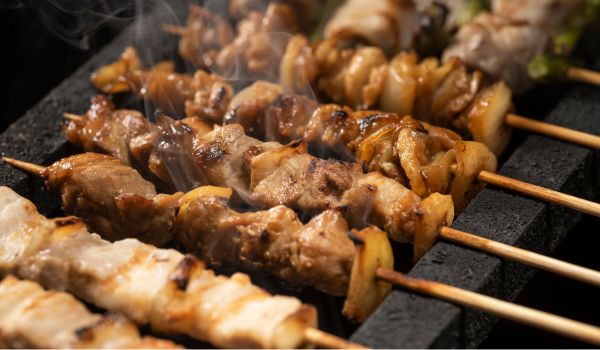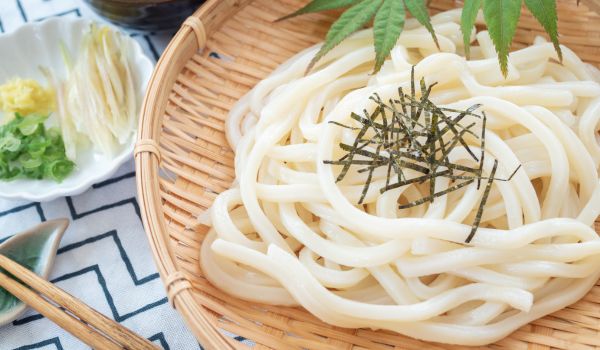The different Japanese culinary specialties
Japanese cuisine is known for being some of the healthiest and most delicious in the world. It consists of a wide variety of dishes, from sushi and ramen to tempura and soba. In this article, we’ll explore some of the most popular Japanese culinary specialties and discover what makes them so tasty and unique.
4. Yakitoris 
Yakitori are Japanese grilled skewers consisting of pieces of meat, vegetables, seafood, and sometimes cheese. They are traditionally made with chicken, but can also be made with beef, pork, fish, or vegetables. Yakitori are often served as a main course or as an appetizer.
Yakitori preparation involves cutting meat or vegetables into small pieces, which are then skewered onto bamboo skewers. The skewers are then grilled over an open fire or grill, giving them a delicious smoky flavor. Yakitori are often brushed with a sweet and savory teriyaki sauce while cooking, giving them an even more intense flavor.
Yakitori are very popular in Japan. They are often sold in street markets. They are also very popular in Japanese restaurants around the world. Yakitori can be served with rice, noodles or stir-fried vegetables for a complete and tasty meal.
Yakitori is a perfect example of simple yet delicious Japanese cuisine. Its combination of meat, vegetables and teriyaki sauce makes it a popular choice for Asian food lovers and those looking to try something new and exciting. If you’ve never tried yakitori before, we recommend starting with the classic meat skewers.
To prepare yakitori, it is advisable to use a versatile knife such as a chef's knife . It will allow you to perform most of the different tasks necessary to make the recipe such as cutting meat, cheese and vegetables.
5. Okonomiyaki 
Okonomiyaki is a popular Japanese food specialty, often described as a kind of Japanese "pancake" or "pizza." The word "okonomiyaki" literally means "what you like, grilled," and it is a very flexible dish that can be made with a wide variety of ingredients depending on your preferences.
The base of okonomiyaki is a thick batter made from flour, eggs and dashi (fish stock), which is then mixed with ingredients such as vegetables, pork, seafood, cheese or kimchi. The batter is then cooked on a griddle or in a pan until golden brown and crispy.
The dish is usually topped with mayonnaise, Okonomi sauce (a thick sauce made with Worcestershire, soy sauce, and ketchup), dried bonito flakes (katsuobushi), and dried seaweed (aonori). Diners can also add additional toppings to their taste, such as pickled ginger, spring onions, or chili flakes.
Okonomiyaki is sometimes prepared on hot plates built into the tables of Japanese specialty restaurants. These are called okonomiyaki-ya. Customers can watch the chef prepare the dish before their eyes before enjoying it while it is steaming hot.
Although okonomiyaki is a popular dish throughout Japan, it originated in the Osaka region, where it is considered a local specialty. There is also a variation called Hiroshima-style okonomiyaki, in which the ingredients are layered rather than mixed into the batter.
In short, okonomiyaki is a tasty and fun dish to enjoy, offering a wide variety of flavors and textures. If you have the opportunity to visit Japan, do not hesitate to try this unique culinary specialty.
While you can use a general-purpose chef's knife to prepare this recipe, we recommend using a slicing knife instead. This type of knife is designed to easily slice through soft foods like Okonomiyaki without tearing them. It's important to have a sharp knife to cut Okonomiyaki cleanly without distorting it.
6. Udons 
Udon are a variety of Japanese noodles, wide and thick, which are popular for their chewy texture and delicate taste. These noodles are traditionally made from wheat flour, water and salt, and are often served in hot or cold broth, with various accompaniments.
Udon noodles have been eaten for centuries in Japan, and have become popular around the world thanks to Japanese cuisine. The noodles can be prepared in a variety of ways, depending on the ingredients and sauces used. They can be served with tofu, vegetables, seafood, meat, or eggs, and can be seasoned with sauces such as soy sauce, mirin, rice vinegar, and dashi.
The preparation of udon can vary depending on the region where it is made. For example, in the Sanuki region of Shikoku, udon is often made with pure spring water and is steamed rather than boiled, giving it a unique texture and distinctive taste.
Udons are also valued for their nutritional value. They are high in carbohydrates, protein, and fiber, and also contain essential vitamins and minerals. They are an excellent source of energy for active people and are often eaten before or after a workout to replenish the body's energy stores.
In conclusion, udon is a delicious variety of Japanese noodles that can be prepared in many different ways and are loved for their chewy texture, delicate taste, and nutritional value. Whether you like them in hot or cold broth, or with different ingredients, udon is a versatile and delicious dish that is definitely worth trying.
You can use the Japanese Nakiri kitchen knife to prepare udon. This type of knife is specially designed for cutting vegetables and is often used to prepare the ingredients that accompany udon, such as green onions and mushrooms.
A final part on Japanese specialties has been specially designed for you. It will be available in a few days. Stay connected!







What are the different Japanese culinary specialties? (Part 1)
What are the different Japanese culinary specialties? (Part 3)